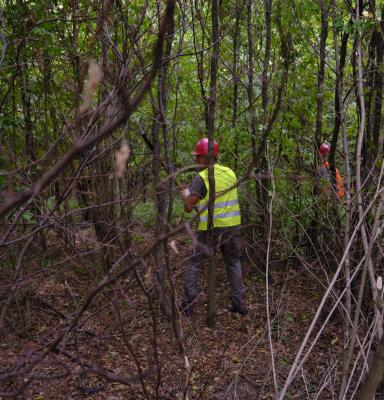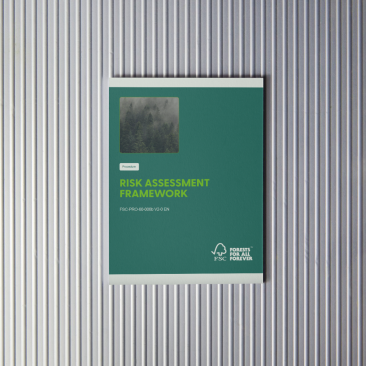

Quick introduction
Learn more about the revised framework and how it can support you on your way towards EUDR compliance.
-
What is the updated Risk Assessment Framework?
With 64 indicators for assessing risks connected to relevant social and environmental aspects, FSC’s Risk Assessment Framework is aligned with EUDR regulatory requirements to ensure responsible sourcing. This framework defines the process and content requirements to develop, review and revise FSC Risk Assessments.
-
Important dates
Approval date: 31 May 2024
Effective date: 1 July 2024
-
What is the objective of updated framework?
The objective of this procedure is to provide requirements to ensure consistent and robust assessment of risks for sourcing material from certain supply areas. In the context of FSC certification, it relates to sourcing timber and/or Non-Timber-Forest Products (NTFPs). Under EUDR, operators and large traders must perform due diligence which includes assessing the risks such as the risk of deforestation and forest degradation (when simplified due diligence is not allowed).
-
What is the scope of updated framework?
This procedure is applicable to developers of FSC Risk Assessments. It specifies the following:
- Process steps and requirements for developing and revising risk assessments through centralised type of processes;
- Maintenance requirements for all risk assessments, independently of the process type;
- Requirements to determine the risk (i.e., ‘negligible risk’ or ‘non-negligible risk’); and
- Requirements for establishing mitigation measures for sourcing material.
How is the new FSC Risk Assessment Framework relevant for me?
In the next few years, FSC will use the the new framework to develop and publish 60 country FSC Risk Assessments (including Bosnia and Herzegovina, Croatia, Serbia and Slovenia). For the list of first 20 countries to receive the new FSC Risk Assessment by 2025, please refer to the question 3 below.
During the time when no updated FSC Risk Assessment exists for a certain country/region, FSC certificate holders aiming to conform with the Regulatory module will have to develop an extended company risk assessments following the requirements under FSC-PRO-60-006b, including a template provided by FSC.
Learn more about the new Risk Assessment Framework
Have a look at the webinar in English language and find out many useful information about the new framework and how you might be able to apply it! When it is time to fill up the Risk Assessment Template, have a look at our Risk Assessment Template Tutorial too.
Frequently Asked Questions
-
What are the major changes proposed to content requirements for Risk Assessments?
The main changes proposed to content requirements can be summarized under the following aspects:
-
A common set of indicators, containing now 64 indicators instead of the 32 indicators. Although there is an increase in the number of indicators, the topics covered are mostly the same (e.g. legality assessment, human and labour rights, HCVs, conversion, GMO, etc.). The requirements have structurally changed through how the proposed indicators are written.
-
Assessment of conversion is now aligned with the FSC-POL-01-007 Policy to Address Conversion and EUDR, including adoption of precautionary approach to assess the risk of conversion. Therefore, a ‘non-negligible’ risk designation shall be applicable as default.
For further information on key content related changes, please read the crosswalk document shared in consultation.
-
-
Who can use FSC Risk Assessments – do I need to be certified?
With the revised FSC-PRO-06-006b Risk Assessment Framework anybody can use the FSC Risk Assessments; there is no requirement for certification.
-
When will the FSC Risk Assessments be available?
The FSC-PRO-60-006b Risk Assessment Framework was published on 1 July 2024. FSC is working to have 20 prioritized Risk Assessments revised and available by 1 March 2025.
Which countries will be prioritized?
FSC has identified 20 priority countries. They are as follows (listed alphabetically): Austria, Brazil, Canada, Chile, China, Estonia, Finland, France, Germany, Indonesia, Latvia, Poland, Portugal, Romania, Spain, Sweden, Türkiye, United Kingdom, Ukraine and USA. FSC will publish related announcements on the process page here.
Note: FSC plans to publish new Risk Assessments for 60 countries during the next few years, countries of the Adria-Balkan Region are included in this scope.
-
Is there anything I can do to support the development of a Risk Assessment in my country?
Stakeholders are encouraged to provide inputs during consultation for the development or revision of a Risk Assessment. In addition, the Risk Assessments will be reviewed and updated annually to ensure that the applicable legislation, risk designations and mitigation measures are up-to-date. The annual review will be based on expert and stakeholder inputs. Stakeholders and experts will have the possibility to continuously provide inputs to the Risk Assessment and share information through an online platform provided by FSC.
-
How can I conduct an EUDR-aligned risk assessment with FSC while waiting for the new Risk Assessments?
If there is no updated FSC Risk Assessment in the country/region, companies aiming to conform with the Regulatory module will have to develop an extended company risk assessments following the requirements under FSC-PRO-60-006b, including a template provided by FSC.
-
Will existing National Risk Assessments from FSC-PRO-60-002a be eligible to use for the FSC Regulatory Module?
No, only risk assessments developed in accordance with FSC-PRO-60-006b Risk Assessment Framework are to be used within the FSC Regulatory Module. Please see Part 4 ‘Forest Management Regulatory Module’ regarding the template provided by FSC to be used by certificate holders to assess the risk if no FSC Risk Assessment exists.
-
How do FSC Risk Assessments go beyond EUDR?
FSC includes environmental and social values through indicators in our current Controlled Wood Risk Assessment Framework which comprise key requirements for FSC system. For example, the assessment of High Conservation Values, child labor including related rights as specified in ILO Fundamental Principles and Rights at Work, among others.
